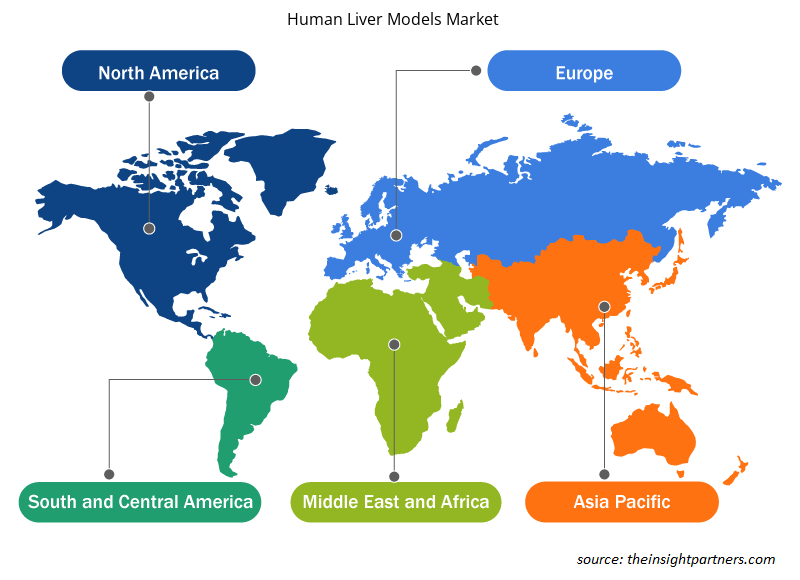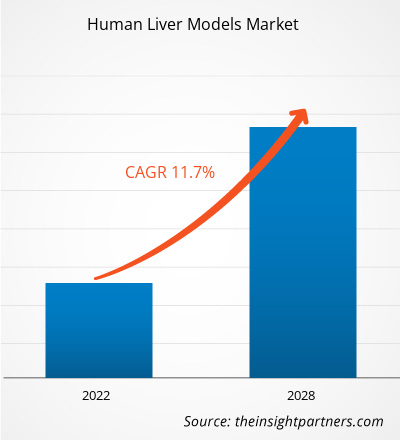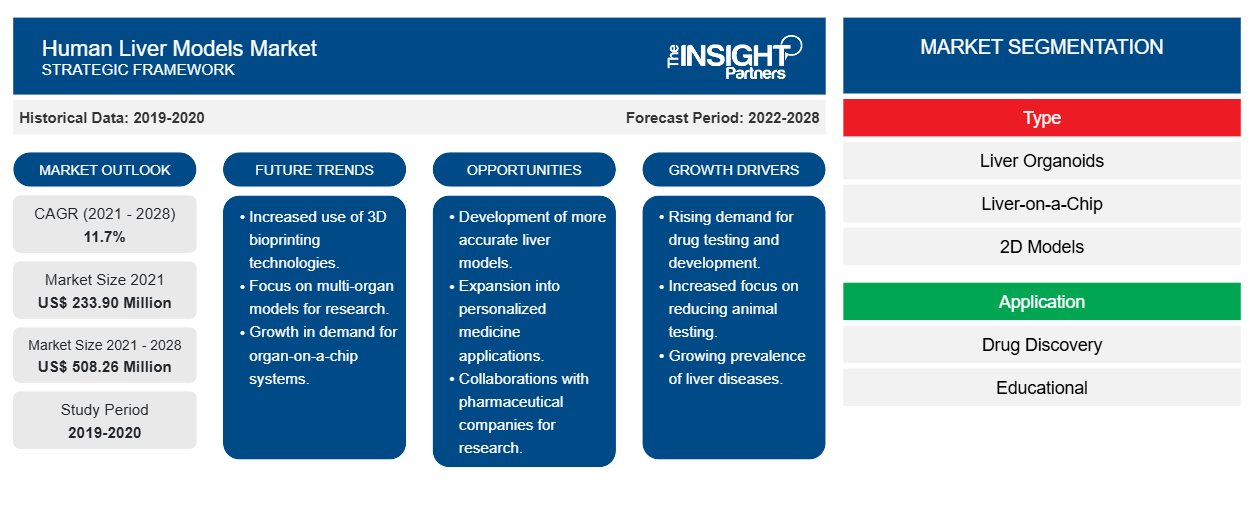Se proyecta que el mercado de modelos de hígado humano alcance los 508,26 millones de dólares en 2028, desde los 233,90 millones de dólares en 2021; se espera que crezca a una CAGR del 11,7% entre 2021 y 2028.CAGR of 11.7% from 2021 to 2028.
El crecimiento del mercado se atribuye principalmente a la creciente prevalencia de enfermedades hepáticas y al creciente enfoque en el desarrollo de alternativas para los modelos de prueba en animales. Sin embargo, los altos costos de los modelos de hígado humano y los problemas con la incorporación de modelos de hígado en el flujo de trabajo existente están obstaculizando el crecimiento del mercado de modelos de hígado humano . El hígado es un órgano importante que realiza funciones corporales vitales como la síntesis de factores de coagulación sanguínea, la producción de bilis, la producción de proteínas y la desintoxicación. Los modelos de hígado humano se utilizan para estudiar la toxicidad de los fármacos y permitir la comprensión del efecto de los fármacos y la progresión de la enfermedad hepática. El creciente enfoque en el desarrollo de alternativas para los modelos de prueba en animales es uno de los principales factores que se estima que fomentarán el crecimiento de los modelos de hígado humano a nivel mundial en los próximos años.
La industria biofarmacéutica de Asia Pacífico se vio afectada durante algunos meses de 2020 debido al brote de COVID-19. La pandemia de COVID-19 ha afectado a los ensayos clínicos de una manera sin precedentes debido a los múltiples niveles de restricciones impuestas para controlar la propagación de la infección. Sin embargo, con la creciente demanda de productos para tratar la infección por COVID-19, las empresas biofarmacéuticas y farmacéuticas de la India y China han aumentado sus actividades de investigación, lo que está impactando positivamente en el crecimiento del mercado.
Personalice este informe según sus necesidades
Obtendrá personalización en cualquier informe, sin cargo, incluidas partes de este informe o análisis a nivel de país, paquete de datos de Excel, así como también grandes ofertas y descuentos para empresas emergentes y universidades.
-
Obtenga las principales tendencias clave del mercado de este informe.Esta muestra GRATUITA incluirá análisis de datos, desde tendencias del mercado hasta estimaciones y pronósticos.
Perspectivas del mercado
La creciente prevalencia de enfermedades hepáticas impulsa el crecimiento del mercado de modelos de hígado humano
El hígado es el órgano interno más grande del cuerpo humano y realiza más de 500 funciones. La toxicidad hepática es una preocupación importante en la evaluación de riesgos, ya que el hígado está expuesto a la mayoría de los compuestos xenobióticos y sus metabolitos bioactivos, lo que lo hace susceptible a la enfermedad hepática inducida químicamente. El virus de la hepatitis C (VHC), el virus de la hepatitis B crónica (VHB), la enfermedad del hígado graso no alcohólico (NAFLD) y la enfermedad hepática asociada al alcohol (ALD) se encuentran entre las principales causas de enfermedad hepática crónica. La hepatitis viral sigue siendo la principal causa de casos de muerte causados por insuficiencia hepática y, al mismo tiempo, la NAFLD se ha convertido en uno de los contribuyentes de más rápido crecimiento a la morbilidad hepática y la mortalidad asociada. Según las estadísticas nacionales del Reino Unido, las enfermedades hepáticas se han clasificado como la quinta causa principal de muerte en el país.xenobiotic compounds and their bioactive metabolites, making it susceptible to chemically induced liver disease. Hepatitis C virus (HCV), chronic hepatitis B virus (HBV), nonalcoholic fatty liver disease (NAFLD), and alcohol-associated liver disease (ALD) are among the leading causes of chronic liver disease. Viral hepatitis continues to be the leading cause of death cases caused by liver failure, and at the same time, the NAFLD has become one of the fastest-growing contributors to liver morbidity and associated mortality. According to the national statistics of the UK, liver diseases have been ranked the fifth-leading cause of death in the country.
Además, estas enfermedades se consideran la segunda causa principal de muerte entre todas las enfermedades digestivas en los EE. UU. Según la Asociación Estadounidense para el Estudio de las Enfermedades Hepáticas, en 2017, la carga mundial de cáncer de hígado y cirrosis había aumentado. Las EHGNA tienen una prevalencia estimada de ~25% en la población general. Casi un tercio de la población estadounidense tiene EHGNA, y las personas con diabetes mellitus tipo 2 u obesidad se ven afectadas desproporcionadamente; se espera que el número de casos de EHGNA aumente de 83,1 millones de personas en 2015 a 100,9 millones para 2030. Por lo tanto, un aumento en la prevalencia mundial de enfermedades hepáticas, incluidas enfermedades crónicas y agudas e infecciones microbianas, aumenta la demanda de modelos hepáticos.NAFLDs have an estimated prevalence of ~25% in the general population. Nearly a third of the US population has the NAFLD, and people with Type 2 diabetes mellitus or obesity are disproportionately affected; the number of cases with NAFLD is expected to increase from 83.1 million people in 2015 to 100.9 million by 2030. Thus, a rise in the global prevalence of liver diseases, including chronic and acute diseases and microbial infections, increases the demand for liver models.
Perspectivas basadas en tipos
Según el tipo, el mercado de modelos de hígado humano se segmenta además en organoides hepáticos, hígado en un chip, modelos 2D, bioimpresión 3D y otros. El segmento de organoides hepáticos tiene la mayor participación del mercado. Sin embargo, se prevé que el segmento de hígado en un chip registre la CAGR más alta durante 2021-2028. Los avances en la tecnología de organoides hepáticos proporcionan modelos para el desarrollo prenatal, la preservación de tejidos y las patologías, lo que impulsaría el crecimiento del mercado de este segmento en los próximos años.organoids, liver-on-a-chip, 2D models, 3D bioprinting, and others. The liver organoids segment holds the largest share of the market. However, the liver-on-a-chip segment is anticipated to register the highest CAGR during 2021–2028. Advances in liver organoid technology provide models for prenatal development, tissue preservation, and pathologies, which would propel the market growth of this segment in the coming years.
Perspectivas basadas en aplicaciones
Según la aplicación, el mercado de modelos de hígado humano se segmenta además en educativo, descubrimiento de fármacos y otros. El segmento de descubrimiento de fármacos tiene la mayor participación en el mercado de modelos de hígado humano; sin embargo, se prevé que el segmento educativo registre la CAGR más alta durante el período de pronóstico.CAGR during the forecast period.
Información basada en el usuario final
Según el usuario final, el mercado de modelos de hígado humano se segmenta en institutos de investigación, empresas farmacéuticas y biotecnológicas, entre otros. El segmento de empresas farmacéuticas y biotecnológicas tiene la mayor participación de mercado. Sin embargo, se estima que el segmento de institutos de investigación registrará la CAGR más alta durante el período de pronóstico. El crecimiento del mercado proyectado para este segmento se puede atribuir a un aumento en las colaboraciones entre la industria y las universidades para la investigación del genoma y los avances tecnológicos en la producción de modelos de hígado humano.CAGR during the forecast period. The projected market growth for this segment can be attributed to an increase in collaborations between industry and universities for genome research and technological advances in the production of human liver models.
Las empresas que operan en el mercado de modelos de hígado humano están adoptando una estrategia de innovación de productos para satisfacer las cambiantes demandas de los clientes en todo el mundo, lo que también les permite mantener su marca en el mercado global.
Perspectivas regionales del mercado de modelos de hígado humano
Los analistas de Insight Partners explicaron en detalle las tendencias y los factores regionales que influyen en el mercado de modelos de hígado humano durante el período de pronóstico. Esta sección también analiza los segmentos y la geografía del mercado de modelos de hígado humano en América del Norte, Europa, Asia Pacífico, Oriente Medio y África, y América del Sur y Central.

- Obtenga datos regionales específicos para el mercado de modelos de hígado humano
Alcance del informe de mercado de modelos de hígado humano
| Atributo del informe | Detalles |
|---|---|
| Tamaño del mercado en 2021 | US$ 233,90 millones |
| Tamaño del mercado en 2028 | US$ 508,26 millones |
| CAGR global (2021-2028) | 11,7% |
| Datos históricos | 2019-2020 |
| Período de pronóstico | 2022-2028 |
| Segmentos cubiertos |
Por tipo
|
| Regiones y países cubiertos |
América del norte
|
| Líderes del mercado y perfiles de empresas clave |
|
Densidad de actores del mercado: comprensión de su impacto en la dinámica empresarial
El mercado de modelos de hígado humano está creciendo rápidamente, impulsado por la creciente demanda de los usuarios finales debido a factores como la evolución de las preferencias de los consumidores, los avances tecnológicos y una mayor conciencia de los beneficios del producto. A medida que aumenta la demanda, las empresas amplían sus ofertas, innovan para satisfacer las necesidades de los consumidores y aprovechan las tendencias emergentes, lo que impulsa aún más el crecimiento del mercado.
La densidad de actores del mercado se refiere a la distribución de las empresas o firmas que operan dentro de un mercado o industria en particular. Indica cuántos competidores (actores del mercado) están presentes en un espacio de mercado determinado en relación con su tamaño o valor total de mercado.
Las principales empresas que operan en el mercado de modelos de hígado humano son:
- TERMOFISHER CIENTIFIC INC.
- Emular, Inc.
- Innovaciones CN Bio,
- KK BIOMÉDICO DE CYFUSE
- MIMETAS BV
Descargo de responsabilidad : Las empresas enumeradas anteriormente no están clasificadas en ningún orden particular.

- Obtenga una descripción general de los principales actores clave del mercado de modelos de hígado humano
Mercado de modelos de hígado humano por tipo
- Organoides hepáticos
- Hígado en un chip
- Modelos 2D
- Bioimpresión 3D
- Otros
Mercado de modelos de hígado humano: por aplicación
- Descubrimiento de fármacos
- Educativo
- Otro
Mercado de modelos de hígado humano: por usuario final
- Empresas farmacéuticas y biotecnológicas
- Institutos de investigación
- Otros
Mercado de modelos de hígado humano por geografía
-
América del norte
- A NOSOTROS
- Canadá
- México
-
Europa
- Francia
- Alemania
- Italia
- Reino Unido
- España
- Resto de Europa
-
Asia Pacífico (APAC)
- Porcelana
- India
- Corea del Sur
- Japón
- Australia
- Resto de APAC
-
Oriente Medio y África (MEA)
- Sudáfrica
- Arabia Saudita
- Emiratos Árabes Unidos
- Resto de MEA
-
América del Sur y Central (SCAM)
- Brasil
- Argentina
- Resto de estafa
Perfiles de empresas
- TERMOFISHER CIENTIFIC INC.
- Emular, Inc.
- Innovaciones CN Bio,
- KK BIOMÉDICO DE CYFUSE
- MIMETAS BV
- InSphero
- BioIVT
- Enlace celular
- Kerafast
- Chipre
- Puesto de iglesia
- ORGANOVO HOLDINGS INC
- Análisis histórico (2 años), año base, pronóstico (7 años) con CAGR
- Análisis PEST y FODA
- Tamaño del mercado, valor/volumen: global, regional y nacional
- Industria y panorama competitivo
- Conjunto de datos de Excel
Informes recientes
Informes relacionados
Testimonios
Razón para comprar
- Toma de decisiones informada
- Comprensión de la dinámica del mercado
- Análisis competitivo
- Información sobre clientes
- Pronósticos del mercado
- Mitigación de riesgos
- Planificación estratégica
- Justificación de la inversión
- Identificación de mercados emergentes
- Mejora de las estrategias de marketing
- Impulso de la eficiencia operativa
- Alineación con las tendencias regulatorias























 Obtenga una muestra gratuita para - Mercado de modelos de hígado humano
Obtenga una muestra gratuita para - Mercado de modelos de hígado humano